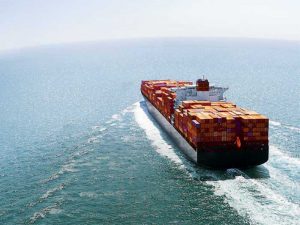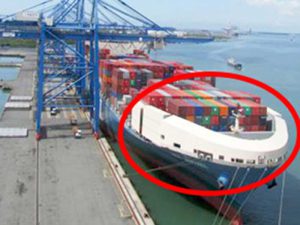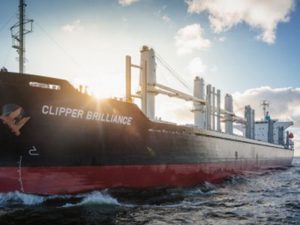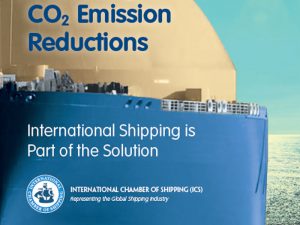
Shipping reaffirms its commitment to cutting CO2 emissions
JUNE 5, 2017 — The United Nations Ocean Conference (5-9 June), organized by the UN General Assembly, opens today in New York and tomorrow, June 6, the International Chamber of Shipping (ICS)

JUNE 5, 2017 — The United Nations Ocean Conference (5-9 June), organized by the UN General Assembly, opens today in New York and tomorrow, June 6, the International Chamber of Shipping (ICS)

MAY 30, 2017 — Japan’s Mitsui O.S.K. Lines, Ltd. (MOL) reports that an in-service demonstration test of a wind resistance-reducing windshield for containerships has shown that the device reduces emissions of carbon

JULY 1, 2016 — The Danish Shipowners’ Association supports global efforts to reduce CO2 emissions from shipping and Danish shipping companies are already undertaking a number of initiatives to limit these emissions.

ICS, whose membership comprises national shipowners’ associations from 37 countries representing more than 80% of the world merchant fleet, has some key messages for government negotiators on the progress shipping is making to reduce its carbon footprint.
According to ICS, the global industry is already delivering carbon neutral growth having reduced total CO2 emissions by more than 10% since 2007, despite an increase in maritime trade.
CO2 emissions from international shipping now represent just 2.2% of the world’s total CO2 emissions compared to 2.8% in 2007 (UN IMO Green House Gas Study, 2014).
“These are genuine reductions through fuel efficiency, without the need for complex virtual measures such as carbon offsets,” said ICS Secretary General, Peter Hinchliffe. “With bigger ships, better engines and smarter speed management, the industry is confident of a 50% CO2 reduction by 2050 when the entire world fleet will comprise super fuel-efficient ships, many using clean fuels such as LNG.”
But in the run-up to the Paris Conference, the shipping industry recognizes that governments expect more.
IMO has already set a mandatory target whereby all ships built from 2025 (including those in developing nations) must be 30% more efficient than ships built in the 2000s. This applies to over 95% of the world merchant fleet, under new regulations that came into force worldwide in 2013.
ICS says that IMO is the only place that can ensure that the entire world fleet will continue to deliver further CO2 reductions, regardless of a ship’s flag, while respecting the United Nations Framework – Convention on Climate Change (UNFCCC) principle of “Common But Differentiated Responsibility.”
ICS stresses that the 10% CO2 reduction achieved since 2007 is across the shipping sector globally, not just ships registered in richer countries which are the only nations required to make commitments for land-based CO2 reductions under the current Kyoto Protocol on climate change.
“The entire world fleet is about 20% more efficient than in 2005. With the support of the shipping industry, IMO has already achieved a great deal and is the only forum that can deliver further significant CO2 reductions from international shipping,” said Peter Hinchliffe.
A new ICS fact sheet “Delivering CO2 Emission Reductions: Shipping is Part of the Solution” can be downloaded HERE
An IMO-commissioned study into the impact of mandatory energy efficiency measures for international shipping shows that implementation of the measures will lead to significant reductions of greenhouse gas (GHG) emissions from ships,
New tankers and bulk carriers built in 2050 could have service speeds of only 5 knots. Partners from nine European countries are working on an EU-funded project called ULYSSES to develop environmentally
Named the “neo Supramax 66BC,” the new ship is an enlarged version of Mitsui’s best selling 56,000 dwt type handymax bulker, for which it has received over 150 orders
Development of the neo Supramax 66BC design involved extensive consultations with shipowners and operators and investigations of more than 600 ports all over the world. The result is a ship designed to have wide beam (36 m) and shallow draft, taking into account current 56BC trading patters and the expansion of Panama Canal, expected in 2014.
The ship is a general use bulk carrier equipped with deck cranes and suited for the carriage of bulk cargoes including coal, iron ore, wheat, barley, soya beans, etc. It can also carry lengthy/heavy cargoes such as steel pipe and hot coil. Hatch openings are optimized for the existing cargo handling equipment at various ports.
Although the neo Supramax 66BC is larger than the 56BC, its fuel consumption less as a result of adopting Mitsui’s newly developed energy-saving hull form.
The shipbuilder is offering two specifications for the ship – Premium and Standard. The Premium model will achieves a reduction of CO2 emission by about 21 percent on a ton-mile basis with a further reduction of up to about 30 percent with the application of optional software and hardware .
Mitsui is also developing measures to meet future SOx and NOx emission controls and requirements for ballast water treatment system is adopted, which is a hot current topic among maritime industries.
Principal Particulars of the Ship
Length overall 200 m
Breadth 36 m
Depth 18.45 m
Full-load draft 12.9 m
Deadweight 66,000 metric tons
Service speed 14.5 knots
Named the “neo Supramax 66BC,” the new ship is an enlarged version of Mitsui’s best selling 56,000 dwt type handymax bulker, for which it has received over 150 orders
Development of the neo Supramax 66BC design involved extensive consultations with shipowners and operators and investigations of more than 600 ports all over the world. The result is a ship designed to have wide beam (36 m) and shallow draft, taking into account current 56BC trading patters and the expansion of Panama Canal, expected in 2014.
The ship is a general use bulk carrier equipped with deck cranes and suited for the carriage of bulk cargoes including coal, iron ore, wheat, barley, soya beans, etc. It can also carry lengthy/heavy cargoes such as steel pipe and hot coil. Hatch openings are optimized for the existing cargo handling equipment at various ports.
Although the neo Supramax 66BC is larger than the 56BC, its fuel consumption less as a result of adopting Mitsui’s newly developed energy-saving hull form.
The shipbuilder is offering two specifications for the ship – Premium and Standard. The Premium model will achieves a reduction of CO2 emission by about 21 percent on a ton-mile basis with a further reduction of up to about 30 percent with the application of optional software and hardware .
Mitsui is also developing measures to meet future SOx and NOx emission controls and requirements for ballast water treatment system is adopted, which is a hot current topic among maritime industries.
Principal Particulars of the Ship
Length overall 200 m
Breadth 36 m
Depth 18.45 m
Full-load draft 12.9 m
Deadweight 66,000 metric tons
Service speed 14.5 knots

Tampa, Fla., based Overseas Shipholding Group, Inc. (NYSE: OSG) has been awarded $3,000,000 by the U.S. Department of Energy for the engineering and design of an articulated tug and barge unit (ATB).

By Sean McLaughlin, Strategy Consultant, Houlder The shipping industry’s decarbonization will partly rely on transportation of CO2. Sean McLaughlin, Strategy Consultant at design and engineering consultancy, Houlder, emphasizes how, as the need